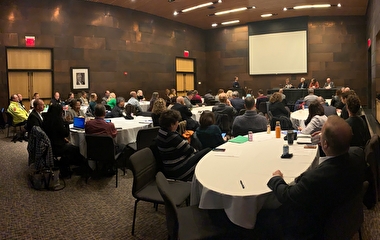MnDOT’s Regional Transportation Management Center (RTMC) collects traffic data from more than 7,800 vehicle detectors to manage the freeway network in the Twin Cities area. A new system developed by University of Minnesota Duluth (UMD) researchers allows MnDOT to monitor the detectors’ health and select those most appropriate for important traffic counts.
The RTMC’s traffic data, collected every 30 seconds from in-pavement loop detectors and mounted radar, provides information about freeway volume, occupancy, and vehicle speed. The data has essential uses beyond daily traffic operations. MnDOT’s Office of Transportation System Management, especially Traffic Forecasting and Analysis (TFA), uses this information to determine annual average daily traffic (AADT). AADT, along with other statistics, is used for federal reporting, traffic forecasting, and maintenance and safety planning.
Because the information informs so many decisions and plans, it is crucial that the data be accurate. “One of TFA’s challenges has been a lack of information about the quality of the loop detector data,” says Gene Hicks, TFA director. “Knowing which detectors are producing high-quality data and which may be in need of repair is key to our planning.”
In a MnDOT-funded project, Professor Taek Kwon of UMD’s Department of Electrical Engineering developed a system that screens loop detector data to allow TFA to generate more accurate estimates of AADT.
Building on previous research that identified faulty detectors, Kwon’s team enhanced previously established diagnostic algorithms for this project. The researchers created and implemented a software tool that classifies loop detectors’ level of functionality by continuously evaluating detector data from the RTMC.
Diagnostic results are conveyed from the central client-server system running the diagnostic program and database to the computers of individual users. A software tool for users, detHealth_app, translates the data into four easily understood health levels for loop detectors: healthy, tolerable, impaired, or nonfunctional.
“The project’s results will enable MnDOT to quickly determine which detectors are providing inaccurate data,” Kwon says. “Better detector data will allow more accurate AADT totals and other volume statistics.”
Detectors that are categorized as healthy can be specified for vehicle counting program use, providing accurate counts. Detectors classified as tolerable can be used only if no healthy detectors are available in the same location. Impaired or nonfunctional detectors are not used for counting but are instead targeted for maintenance operations.
“This project saves us time in checking traffic sensor health to determine if detectors are working or are in need of repair,” Hicks says. “Repairs are now done quickly. The project improves the accuracy of data we use for official traffic volumes.”
The system, now operating for the Twin Cities freeway system, also provides many additional categories of information about the detectors.
The project’s success led to the expansion of the effort with an additional research project, which is now in progress. The new project will work toward using loop detector data to categorize the types of vehicles passing over the detectors. It will make another area of information easily available to TFA professionals, enhancing their ability to make accurate traffic forecasts and better decisions.



